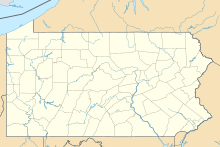Bedford Village Archeological Site
Coordinates: 40 ° 2 ′ 31.2 " N , 78 ° 30 ′ 38.4" W.
Bedford Village Archeological Site (also Site 36BD90 ) is an archaeological site in central Bedford County , Pennsylvania in the United States . It is located in Bedford Township north of Bedford and was once a village of the Monongahela culture . Today the Old Bedford Village , an open-air museum, is located here .
description
The Monongahela settlement that was once on this site consisted of round houses surrounded by a palisade , common for such settlements. The village arose at the highest point of a terrace on the Raystown Branch of the Juniata River above the swampy areas in the floodplain of the river. This location is atypical for the Monongahela, as they usually settled in high elevations in order to be able to defend themselves better. The villagers built their houses similar to those in other settlements. The diameter of a house in the village is known to be about seven meters, as in most other Monongahela settlements. Based on archaeological finds, it is believed that the village was only inhabited for a short period of time, probably two generations, sometime between 1250 and 1600.
After the arrival of European settlers in the area, the hardwood forest was cleared and farmed for many years. Farming ceased in the mid-1970s when the Bedford County Redevelopment Authority received federal funding to build an open-air museum on the site. This was established in 1975 and 1976.
Excavations
Prior to the creation of the open-air museum, the site was known to locals as the site of artifacts , but it was only after the museum was established that the archaeological potential of the site was recognized. Experimental excavations in the northern area of the site in 1977 produced evidence of the existence of a Monongahela village and a use before the Monongahela culture, which dates back to the late Archaic period . During the summer months of 1979 and 1980, Pennsylvania State University conducted additional, more extensive excavations at various locations in the open air museum, uncovering palisade moats that encircled most of the village.
The archaeological site was severely affected by the construction activity in the context of the construction of the museum village, as the buildings and supply lines were built on the former settlement and a gravel path now leads over the site. The use of the heavy machinery could also have buried Køkkenmøddinger on the edge of the settlement terrace. Three quarters of the site remained unaffected by the construction work, and it is not to be expected that other areas of the site will be affected by the open-air museum.
meaning
The Bedford Village Archeological Site illustrates an unusual mix of different phases in the Native American colonization of the region. It is believed that this village, which is one of the easternmost settlements of the Monongahela culture, represents the transition between the Monongahela culture and other peoples in central Pennsylvania. The location of the settlement itself was used as evidence of climate change in North America. According to this, a climate that became colder around 1500 is said to have caused the Monongahela to leave their houses on the mountain tops and to go to the warmer river valleys.
The questions raised about the influence of other cultures are particularly significant because artifacts have also been found at the Shenks Ferry Site in Lancaster County , eastern Pennsylvania. Although this evidence is minimal, it indicates a short-term settlement of the Shenks Ferry Site after the presence of the Monongahela culture, as kitchen waste was found over a palisade created by the Monongahela culture at the excavation site there.
Due to its size and degree of preservation, the archaeological site in Bedford was entered on the National Register of Historic Places in 1984.
literature
- James W. Hatch: An Archaeological Assessment of Construction Impacts at Old Bedford Village, Bedford County, Pennsylvania . William Penn Memorial Museum, Harrisburg , PA. 1979.
Web links
- Old Bedford Village . Open air museum website
Individual evidence
- ↑ a b c d e f g h i j k Ira Beckerman: Site 36BD90 . In: National Register of Historic Places Inventory / Nomination ( English ). National Park Service .
- ^ A b Richard L. George: Deffenbaugh Site (36FA57) . In: National Register of Historic Places Inventory / Nomination ( English ). National Park Service , Jul 31, 1981, p. 3.
- ↑ National Register Information System ( English ) In: National Register of Historic Places . National Park Service. Retrieved August 13, 2012.

